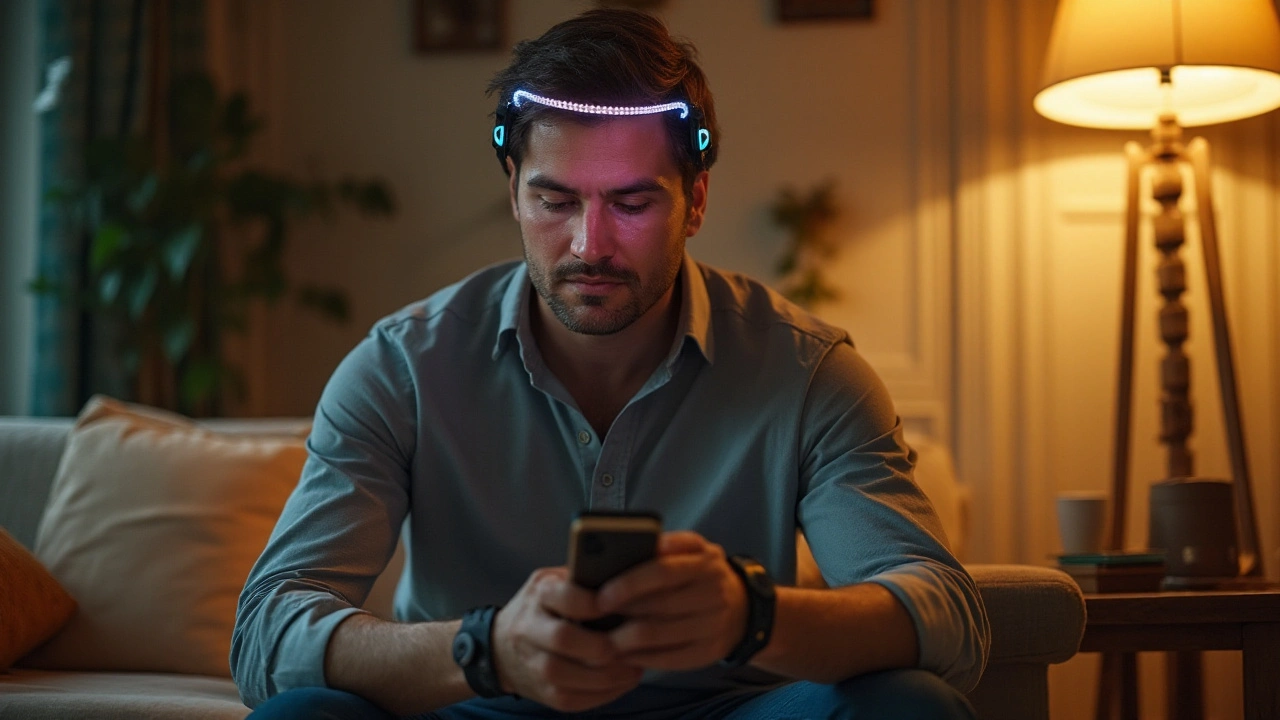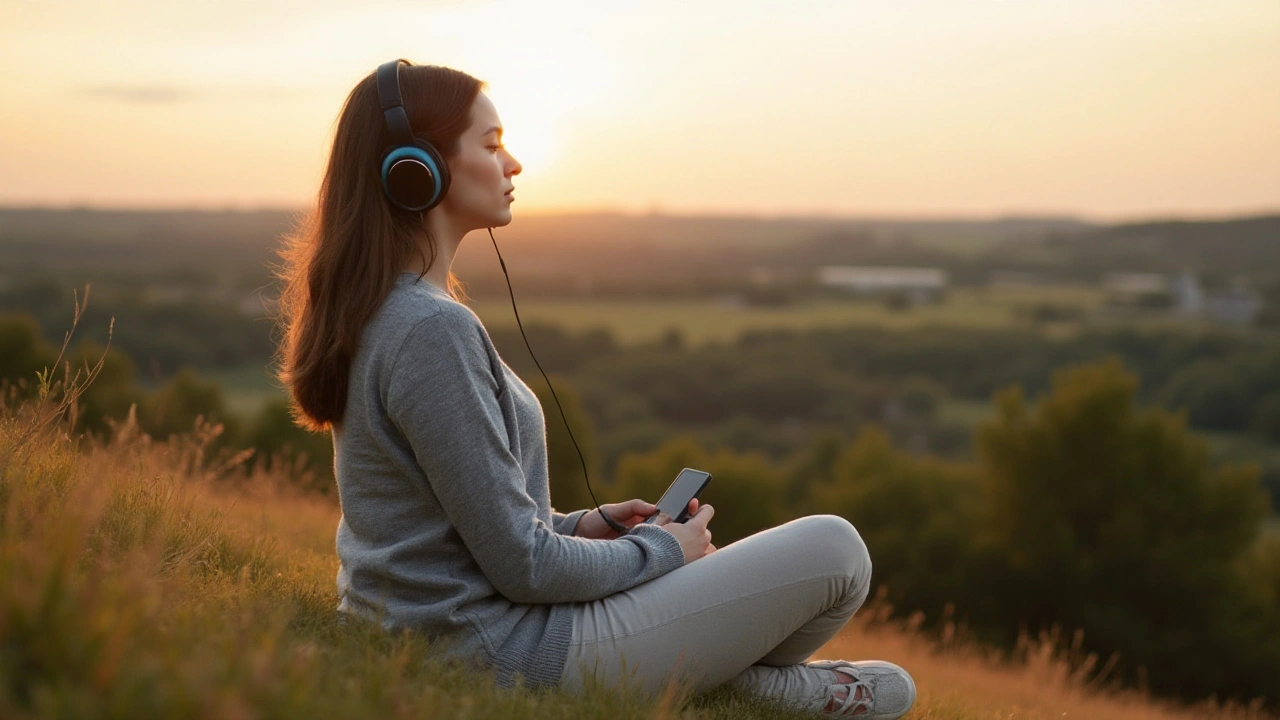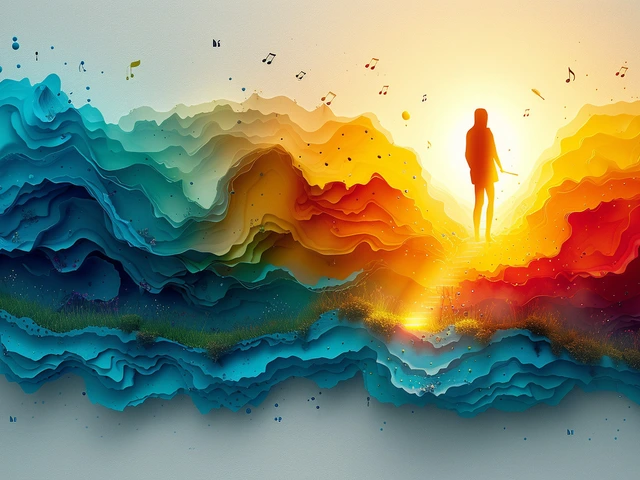In today's fast-paced world, anxiety is an uninvited guest that shows up more often than we'd like. Intense work demands, personal responsibilities, and global events all contribute to feelings of overwhelm. But what if there was a way for your body to tell you what it needs, so you can respond with calmness and control?
Biofeedback offers a fascinating solution. Imagine harnessing the power of technology to tune into the subtle signals your body sends in times of stress. It's akin to holding a mirror to your physiological processes—such as heart rate, muscle tension, and brain waves—and observing them, so you can guide yourself toward relaxation. This article will unravel the simple yet profound methods of biofeedback and explore how they can transform your response to anxiety.
- Understanding Biofeedback
- How Biofeedback Helps with Anxiety
- Different Types of Biofeedback Techniques
- The Science Behind Biofeedback
- Practical Tips for Using Biofeedback
- Incorporating Biofeedback into Daily Life
Understanding Biofeedback
Biofeedback is a mesmerizing intersection of modern science and self-awareness, a tool that has been revolutionizing how we approach mental and physical health for decades. At its core, biofeedback involves using precise sensors attached to the body to monitor physiological processes we generally have little control over, like heart rate, muscle tension, and stress-induced changes. These sensors relay this information to you, often through visual or auditory cues, giving a real-time update on what's happening inside your body. This instant feedback loop empowers you to adopt practices that can directly affect these processes, effectively helping you coax your body into a calmer state, improving your mental health and stress management abilities.
The origins of biofeedback date back to the late 1960s, when scientists were exploring how people might gain control over supposed involuntary physiological functions. They discovered that, with practice, individuals could influence heart rates or relax certain muscles through feedback-driven training. To debunk a common myth: biofeedback is not about making your mind perform tricks in isolation. Instead, it is about creating harmony between mind and body—a principle deeply rooted in therapeutic traditions that recognize the body's wisdom and capacity for healing. One compelling study published in the Journal of Applied Psychophysiology suggests that consistent biofeedback practices have been linked to a substantial reduction in symptoms of anxiety and chronic pain.
A remarkable finding from the Cleveland Clinic states, "Biofeedback can be an effective tool to teach patients how to regulate their physiological responses and improve their health conditions using mindfulness techniques blended with science."
Today, a variety of biofeedback types exist, tailoring to specific therapeutic needs or preferences. There is heart rate variability feedback, where you can learn to stabilize heart patterns, or electroencephalography (EEG), which focuses on brainwave activity. Each offers unique insights into different aspects of your well-being and can be adjusted to suit personal requirements. It's akin to having a personalized health manual tailored to address your stressors. Incorporating these methods enables individuals to sharpen their self-awareness and develop better emotional resilience. As biofeedback continues to gain popularity, many people are finding it immensely valuable, not just for anxiety relief, but as a cornerstone of comprehensive strategies to maintain whole-body wellness.
Biofeedback is not a magic pill but a journey—a journey towards greater self-understanding and self-regulation. It teaches patience and encourages patients to become active participants in their own healing, allowing them to manage their health proactively. In a world filled with digital chaos, this method shines as a beacon of hope and self-empowerment, reminding us that with knowledge and proper tools, we have the potential to change our physiological and psychological states meaningfully.
How Biofeedback Helps with Anxiety
Managing anxiety can feel like an uphill battle, one that can be both exhausting and disheartening. Biofeedback emerges as a shining beacon, providing an avenue to regain control. At the heart of this technique lies the concept of mindfulness paired with technology. By using sensors to monitor physiological signals—such as heart rate, muscle tension, and skin temperature—it opens a door to better self-regulation. For many, the real-time visual feedback creates an impactful learning experience, allowing people to understand their body's responses to stress, and crucially, how to moderate them. This learning comes with the added benefit of enabling individuals to respond more calmly in anxiety-provoking situations. Imagine seeing the immediate consequences of your attempts to relax; that empowerment is invaluable.
One interesting aspect of biofeedback is its ability to foster self-awareness. It equips individuals with the information needed to identify patterns that often go unnoticed. For instance, many people may not realize the extent of their muscle tension or how their breathing changes under stress. Addressing these elements can be transformative. The meta-awareness creates a link between knowing something on a cognitive level versus actually feeling and seeing the change. Practitioners often describe biofeedback therapy as a 'mind-body check-in,' a way to pause, evaluate, and adjust in real-time by seeing the actual data.
Biofeedback doesn't just serve as a diagnostic mirror but works proactively as well. By seeing how behavior and thought patterns affect physical stress responses, individuals can learn to use self-regulation techniques to bring about a desired state. Studies show that employing biofeedback can reduce the frequency of panic attacks and lessen overall anxiety symptoms. The use of technology in this way provides a sense of agency that many people find lacking in typical anxiety treatments. In fact, a study by The Journal of Clinical Psychology suggested that patients undergoing biofeedback training demonstrated significantly lower levels of anxiety-related hormones like cortisol. This helps illuminate why biofeedback is becoming an integral part of holistic anxiety management strategies.
"Biofeedback is an effective tool in treating anxiety disorders because it teaches patients how to consciously control physiological functions that are usually involuntary," says Dr. Lisa Lewis, a renowned psychologist. "With repeated practice, many find they can face anxiety triggers with a newfound calm and resilience."
What sets biofeedback apart from some traditional interventions is its non-invasive nature. There are no medications involved, no side effects—just a commitment to consistency and practice. Given the customizable nature of these sessions, biofeedback is accessible and adaptable. It is flexible enough to fit within a variety of therapeutic frameworks, whether it's learning deep breathing exercises, practicing progressive muscle relaxation, or even applying visualization techniques. This positions it as not just a treatment, but a vital skill that becomes part of everyday life, driving one towards improved overall mental health.

Different Types of Biofeedback Techniques
Biofeedback is a fascinating field with a suite of techniques tailored to helping individuals manage their anxiety levels effectively. Each method focuses on a specific physiological process, coached into awareness so that it can be consciously controlled. This customization makes biofeedback a versatile tool, able to be adapted according to the unique needs of each person facing stress and anxiety challenges.
One well-established technique is Electromyography (EMG), which measures muscle tension. When stress causes muscles to tighten, this method can help individuals recognize which habits lead to tension, guiding them to relax those muscles consciously. Another approach involves Thermal Biofeedback, which keeps track of blood flow by monitoring skin temperature. Surprisingly, stress often causes cool skin as blood vessels constrict, and by becoming aware of such signals, a person can practice warming their fingers and hands, thus promoting relaxation across the body.
Another popular technique is Heart Rate Variability (HRV) Biofeedback. This measures the time between heartbeats, which reflects the balance between stress and relaxation responses. Through HRV biofeedback, one learns to consciously guide their heart rate variability, strengthening their ability to maintain calm. A more specialized method, Galvanic Skin Response (GSR), detects changes in skin perspiration caused by intense emotions. With practice, users can develop a keen awareness of these subtle changes, enabling a quicker, mindful intervention before anxiety takes over.
According to Dr. Aimee Colbert, a noted psychologist, 'Biofeedback represents an empowering way to retrain the body's responses to stress, allowing individuals a much-needed space to breathe and reset.'
Beyond these, Neurofeedback focuses on brain activity. Electroencephalography (EEG) sensors used in Neurofeedback measure brain waves, helping people with anxiety disorders learn to shift their brain wave patterns towards states of greater relaxation or focus. This technique is not only gaining popularity for anxiety relief but also for enhancing cognitive function and focus, offering a holistic improvement in mental wellness. Interestingly, whatever the technique, the goal remains the same—achieving improved mental states through conscious control over bodily functions.
The potential of these varied approaches can be best understood through their applications in daily life. For instance, by participating in EMG biofeedback sessions, people can steadily reduce chronic neck and shoulder tension caused by prolonged office work. Thermal biofeedback can become a go-to during winter months when cold tends to exacerbate worries and stressors. Choosing the right type of biofeedback can transform one's approach to tackling stress, making these methods an invaluable addition to the toolkit against anxiety.
| Technique | Primary Measurement | Common Application |
|---|---|---|
| EMG | Muscle tension | Chronic pain, tension headaches |
| Thermal | Skin temperature | Stress management |
| HRV | Heart rate variability | Anxiety reduction, resilience |
| GSR | Skin perspiration | Emotional regulation |
| Neurofeedback | Brain waves | Focus, cognitive enhancement |
The Science Behind Biofeedback
Biofeedback is an intriguing blend of biology and technology. At its core, it operates on the principle that we can learn to control bodily processes generally considered involuntary, like heart rate and breathing. This might sound a touch futuristic, but it heavily relies on the natural plasticity of our brain, known as neuroplasticity. This phenomenon refers to the brain's ability to change, adapt, and even re-wire itself, influenced by behavior, environment, and experiences—this is where biofeedback works its magic.
When a person is hooked up to a biofeedback device, sensors provide real-time feedback about bodily functions. These can range from electrical activity in the muscles, detected through electromyography, to the temperature of the skin. For individuals battling anxiety, seeing these immediate readings helps make the invisible visible, turning abstract internal processes into something concrete and understandable. As they experiment with different relaxation techniques, they can watch their readings change, which is not only fascinating but deeply empowering.
Scientific studies have supported biofeedback's ability to impact anxiety reduction. By providing information about the body's stress responses, individuals are not only educated about their unique physiological blueprint but also guided to reset their stress responses in real-time. In this way, the biofeedback process can be likened to a tutor providing timely feedback, ensuring you're on track to acing the test known as life's stressors. While there are numerous studies, a recent one published in the journal of Applied Psychophysiology and Biofeedback highlights an intriguing fact: patients who practiced biofeedback techniques showed significant reductions in anxiety levels compared to those who did not.
According to Dr. Mary Kowalski, "Biofeedback represents a significant step forward in self-regulation approaches, empowering patients to gain greater control over anxiety with tangible evidence of bodily changes," as reported in a 2022 interview.
Despite its high-tech feel, the science isn't too complex. By harnessing our natural ability to adapt, biofeedback taps into the mind-body connection, reminding us of our innate power to influence our emotions. Statistics reflect the growing acceptance and application of biofeedback. A survey conducted in the United States found that over 65% of respondents who had experienced biofeedback recommended it as a viable option for anxiety management among their peers.
Anxiety relief and mental wellness, through biofeedback, thus arch out of the intangible and enter the realm of achievable reality, offering hope, and a pathway to control, beyond pills and therapy sessions. So, the next time anxiety strikes, remember this powerful tool lies within reach, grounded as much in science as in the mystery of the human capacity to change.

Practical Tips for Using Biofeedback
Diving into the world of biofeedback to manage anxiety might feel like embarking on a new adventure. But don't worry, it's a journey that's entirely doable with a bit of guidance and practice. First thing's first: understanding the technology and the tools at your disposal. Many biofeedback devices, like heart rate monitors and electroencephalograms (EEG), are available for personal use. A starting point could be something as simple as a wearable heart-rate tracker that helps you monitor your pulse and signals stress levels whenever they spike. The beauty of such devices lies in their ability to provide you real-time insights, allowing you to act swiftly to ease anxiety when it rears its head.
Learning to control these physiological responses can transform how you experience stress. For instance, deep-breathing exercises, when done using biofeedback equipment, give you visual or auditory cues to help pace your breathing. Aligning your mind and body in such a manner can create a calming effect. According to a study published by the American Psychological Association, biofeedback techniques have been shown to significantly reduce symptoms in patients with chronic anxiety disorders. This is proof that these methods are not only grounded in science but also in practical, lived experiences.
Integrating Biofeedback into Routine
One of the great things about biofeedback is its flexibility. You can integrate these practices seamlessly into your daily routine. Start small, perhaps setting aside a designated quiet time each day. Even ten minutes can make a difference. Use this period to engage with your biofeedback tools—whether it's listening to your heart or observing your muscle tension. Silent mornings or tranquil evenings can serve as perfect backdrops for this practice. Soon, you'll find yourself naturally gravitating towards these moments, looking forward to the calm they bring.
Another significant tip is to keep a record of your progress. Documenting your sessions can reveal patterns and triggers that you may not otherwise notice. Journaling about what works and what doesn’t can be instrumental in refining your approach to anxiety relief. Over time, this personalized understanding becomes invaluable, leading to even better management of stress.
"Biofeedback is a demonstration of the mind’s power over the body," shares Dr. Patricia Norris, a pioneer in the field. Her words highlight the profound potential locked within these practices to transform mental health.
You can also consider joining biofeedback training sessions. These are often available online, giving you access to expert guidance without ever leaving your home. This community interaction can provide support, offer fresh insights, and enhance mastery of biofeedback techniques.
Finally, remember that patience is key. Just like any new skill, mastering biofeedback will take time and dedication. Approach it with an open mind and a willingness to learn, and the journey itself can become immensely rewarding.
| Biofeedback Benefit | Typical Equipment |
|---|---|
| Heart Rate Variability Training | Heart Rate Monitor |
| Muscle Relaxation | Electromyogram (EMG) |
| Brainwave Monitoring | Electroencephalogram (EEG) |
Incorporating Biofeedback into Daily Life
Bringing biofeedback into your daily routine might sound challenging at first, but it's easier than you think. The key is consistency and making biofeedback a natural part of your lifestyle. One of the most effective ways to start is by setting aside a dedicated time each day for your biofeedback sessions. Choose a quiet space where you can engage without interruptions, using a comfortable chair or yoga mat. This sacred space should be free from distractions, creating an environment that facilitates relaxation and focus.
During your biofeedback sessions, it helps to combine technology with mindfulness techniques. For example, while using sensors to monitor your heart rate or breathing patterns, pay attention to how your body responds to different thoughts or visualizations. This is not just about tracking data; it's about understanding how your body communicates. Practicing deep breathing while observing your heart rate can teach you how to lower it consciously. This skill is transferrable to situations when anxiety sets in, allowing you to regain control naturally.
Another fantastic way to incorporate biofeedback is through mobile apps, which bring this tool's benefits to your fingertips. These apps provide real-time feedback on your physiological states, empowering you to make instant adjustments. Most of them come with guided practices that teach you how to interpret the data and adjust your mental and physical responses. According to a study by the American Psychological Association, people who used biofeedback apps reported a significant reduction in stress levels within just a few weeks.
"Biofeedback is not just a treatment; it's a form of self-mastery," says Dr. Laura Hastings, a leading psychologist specializing in stress management. "Once you understand your unique stress responses, you can manage them effectively without external help."
Incorporating biofeedback into family activities can also be beneficial. Introducing these practices to children can teach them the importance of self-awareness from an early age. Simple exercises, such as using a biofeedback toy or game, can turn learning into play while teaching kids how to calm themselves in stressful situations. For adults, sharing experiences like these requires patience and encouragement, but the collective understanding and practice can create a supportive atmosphere for everyone involved.
Group sessions or community workshops can provide opportunities to learn alongside others and share insights. They offer a supportive environment for exchanging tips and tricks for a successful biofeedback journey. Consider joining or starting a biofeedback group in your neighborhood or workplace. Or try hosting a virtual session if face-to-face meetings aren’t feasible. This collective approach not only boosts motivation but also builds a sense of camaraderie, enhancing the therapeutic process.
Remember, stress management is a lifelong journey. Biofeedback can become an integral part of your ongoing personal development. The more naturally you can weave these practices into your daily activities, the more effective they will be. Practice patience, celebrate small victories, and allow yourself to grow into these new habits. By gaining insight into your body through biofeedback, you're not just managing anxiety; you're unlocking a deeper understanding of your well-being. Consider setting goals and tracking your progress to see how far you've come, which can serve as a motivator and a testament to the power of biofeedback.





